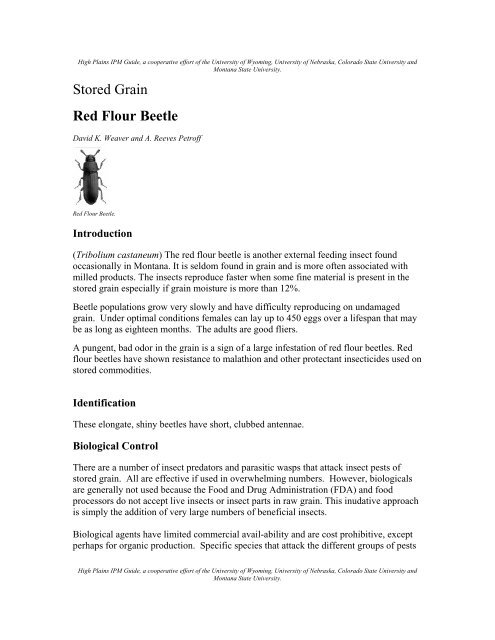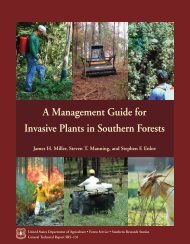Stored Grain Red Flour Beetle
Stored Grain Red Flour Beetle
Stored Grain Red Flour Beetle
You also want an ePaper? Increase the reach of your titles
YUMPU automatically turns print PDFs into web optimized ePapers that Google loves.
High Plains IPM Guide, a cooperative effort of the University of Wyoming, University of Nebraska, Colorado State University andMontana State University.<strong>Stored</strong> <strong>Grain</strong><strong>Red</strong> <strong>Flour</strong> <strong>Beetle</strong>David K. Weaver and A. Reeves Petroff<strong>Red</strong> <strong>Flour</strong> <strong>Beetle</strong>.Introduction(Tribolium castaneum) The red flour beetle is another external feeding insect foundoccasionally in Montana. It is seldom found in grain and is more often associated withmilled products. The insects reproduce faster when some fine material is present in thestored grain especially if grain moisture is more than 12%.<strong>Beetle</strong> populations grow very slowly and have difficulty reproducing on undamagedgrain. Under optimal conditions females can lay up to 450 eggs over a lifespan that maybe as long as eighteen months. The adults are good fliers.A pungent, bad odor in the grain is a sign of a large infestation of red flour beetles. <strong>Red</strong>flour beetles have shown resistance to malathion and other protectant insecticides used onstored commodities.IdentificationThese elongate, shiny beetles have short, clubbed antennae.Biological ControlThere are a number of insect predators and parasitic wasps that attack insect pests ofstored grain. All are effective if used in overwhelming numbers. However, biologicalsare generally not used because the Food and Drug Administration (FDA) and foodprocessors do not accept live insects or insect parts in raw grain. This inudative approachis simply the addition of very large numbers of beneficial insects.Biological agents have limited commercial avail-ability and are cost prohibitive, exceptperhaps for organic production. Specific species that attack the different groups of pestsHigh Plains IPM Guide, a cooperative effort of the University of Wyoming, University of Nebraska, Colorado State University andMontana State University.
High Plains IPM Guide, a cooperative effort of the University of Wyoming, University of Nebraska, Colorado State University andMontana State University.are listed below. It is important to note that there are limited numbers of naturallyoccurring biological control agents:Primary PestsParasitic wasp of grainAnisopteromalus calandraeChoetospila elegansLariophagus distinguendusPredaceous mitesWarehouse pirate bug - Xylocoris flavipesSecondary PestsPredaceous mitesWarehouse pirate bug - Xylocoris flavipesIndianmeal mothHabrobracon hebetorPredaceous mitesTrichogramma pretiosumWarehouse pirate bug - Xylocoris flavipesInsecticide TreatmentsEmpty bin treatments include residual insecticides applied in and around the fan, aerationducts, auger, door openings, and hatch covers, or fumigants, before bins are filled atharvest. Commercial facilities must comply with the Occupational Safety and HealthAdministration (OSHA) bin entry permits. Following are pesticides available for treatingempty bins:Insecticides Labeled for Use as Empty Bin TreatmentsActive Ingredient Example Brands Comments / Usage(a.i.)CyfluthrinTempo Sc UltraPremise Spray®Most effective residual as compared withmalathion and chloripyrifos-methyl.Chlorpyrifos-methyl Reldan 4E® Can only be applied from outside of bin andsprayed downward into the bin. Degradeson hot surfaces.Diatomaceous earth(DE)Insecto, Protect-it®Excellent empty bin treatment. Specialgrade required for grain use. Must use DElabeled for grain.Malathion Malathion No longer recommended for empty grainbins because of high insect resistance andHigh Plains IPM Guide, a cooperative effort of the University of Wyoming, University of Nebraska, Colorado State University andMontana State University.
High Plains IPM Guide, a cooperative effort of the University of Wyoming, University of Nebraska, Colorado State University andMontana State University.rapid degradation in warm, relatively moistgrain.Chlorpyrifos-methyl+ cyfluthrinStorcide® Can only be applied from outside of bin andsprayed downward into bin. It is notrecommended for grain intended for export.Chloropicrin Chlor-o-pic® Empty bin fumigant, under false floor,aeration tubes, and tunnels.Methyl bromide Brom-o-gas®, Empty bin fumigant; seldom used.othersPhosphine Phostoxin®, others Empty bin fumigant.Liquid Insecticides Labeled for Use as <strong>Grain</strong> ProtectantsActive Ingredient Example Brands CommentsChlorpyrifos-methyl Reldan 4E® Reldan does not control lesser grain borer.Can only be applied to the grain stream asit is moved (augered) into the bin. Uselimited to existing stocks.Malathion Malathion 5EC Existing stocks are available but label hasbeen withdrawn. Most stored grain insectsare resistant.DDVP Vapona® Also as strips. Used in the head spaceagainst Indianmeal moth.MethopreneChlorpyrifos-methyl +cyfluthrinGentrol, DiaconII®Storcide®Kills developing insects only, slow kill oflarvae, no kill of adults though causessterility. High cost and must use otherproducts before sale. Newly marketed.Can only be applied to the grain stream asit is moved (augered) into the bin. It is notrecommended for grain intended forexport.Pyrethrins Pyrenone® Expensive, short residual life.<strong>Grain</strong> protectants are insecticides applied directly onto grain going into the storage oralready in storage. <strong>Grain</strong> protectants do not kill insects inside the kernels. Following areinsecticides labeled as protectants.In Montana, the use of protectants should be limited to high-value commodities that needprotection during storage for several months, and for which it is cost effective to use them.For direct application on wheat at first storage, there are limited circumstances where theuse of a protectant is necessary.Dust Insecticides Labeled for Use as <strong>Grain</strong> ProtectantsActive Ingredient Example Brands CommentsMalathion Big 6 <strong>Grain</strong> Protector®, Top-dress treatment. Insects areHigh Plains IPM Guide, a cooperative effort of the University of Wyoming, University of Nebraska, Colorado State University andMontana State University.
High Plains IPM Guide, a cooperative effort of the University of Wyoming, University of Nebraska, Colorado State University andMontana State University.Diatomaceous earth(DE)Agrisolutions 6%Malathion <strong>Grain</strong> DustProtect-It, Insecto®resistant in many areas. Millers resistpurchasing grain with strongmalathion odor.Can lower the test weight of grain andis expensive if it is applied to entiregrain mass, so is best applied to emptybins and to the top and bottom layersof the grain mass.The information herein is supplied with the understanding that no discrimination is intended and that listing of commercial products, necessaryto this guide, implies no endorsement by the authors or the Extension Services of Nebraska, Colorado, Wyoming or Montana. Criticism ofproducts or equipment not listed is neither implied nor intended. Due to constantly changing labels, laws and regulations, the Extension Servicescan assume no liability for the suggested use of chemicals contained herein. Pesticides must be applied legally complying with all label directionsand precautions on the pesticide container and any supplemental labeling and rules of state and federal pesticide regulatory agencies. State rulesand regulations and special pesticide use allowances may vary from state to state: contact your State Department of Agriculture for the rules,regulations and allowances applicable in your state and locality.Categories: <strong>Stored</strong> <strong>Grain</strong>, Insects, red flour beetle, Tribolium castaneumDate: 12/20/2004High Plains IPM Guide, a cooperative effort of the University of Wyoming, University of Nebraska, Colorado State University andMontana State University.
















